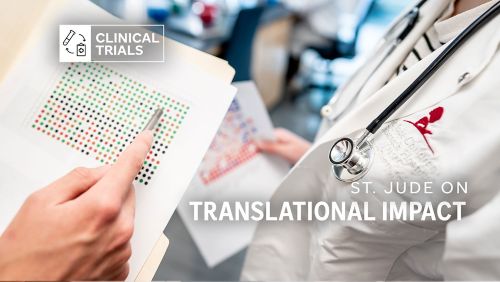St. Jude Family of Websites
Explore our cutting edge research, world-class patient care, career opportunities and more.
St. Jude Children's Research Hospital Home

- Fundraising
St. Jude Family of Websites
Explore our cutting edge research, world-class patient care, career opportunities and more.
St. Jude Children's Research Hospital Home

- Fundraising
Translating lab discoveries to clinical trials in the age of personalized medicine

Addressing the most challenging ALL cases requires understanding them at a fundamental and individual level. By exploring patient responses to treatments, researchers can translate their findings to clinicians to inform on potential individualized approaches to treatment.
The birth of modern medicine saw a shift from treating the individual to treating the masses. The ability to quickly optimize and screen drugs, test a broad swath of candidate therapies and cure fatal illnesses on a global scale meant that standardized treatment practices became the norm for most diseases, including cancers.
Since opening its doors in 1962, St. Jude has been a driving force behind increasing the survival of patients with acute lymphoblastic leukemia (ALL) to 94%. Much of this success comes from implementing standardized practices, matching the urgency of the illness with a rapid response.
Scientific discovery continues to challenge the most difficult to treat cases, and huge gains have been made in our understanding of the disease and its genetic and molecular composition. The bottleneck now lies in how these advances translate to the clinic. This issue has left scientists and clinicians asking: how do we take advantage of fundamental scientific advancements to treat challenging ALL cases?
How and why individuals respond to therapy
Sometimes, the answer to progress is offered in a glance back. The initial vision of medicine saw Hippocrates postulate on how humans are inherently (or to be exact, genetically) different. These differences, which account for only 0.9% of our genetic makeup, largely decide how disease affects us and how we respond to treatment.
While it has been over 2,000 years since Hippocrates’s time, early medicinal practices have a few things in common with the current practice of pharmacotyping. This includes observing how a patient responds to treatment, characterizing that response and determining the most effective and safe way to treat the disease. Whereas Hippocrates observed the humors of blood, bile and phlegm, researchers today use advanced genomic techniques to better understand inter-patient variability in drug response.
At St. Jude, Jun J. Yang, PhD, Department of Pharmacy and Pharmaceutical Sciences and Department of Oncology, applies the fundamentals of pharmacotyping with the goal of increasing ALL survival from 94% all the way to 100%.
“In cancer genomics, most people start with tumor sequencing and once a mutation is detected, the hope is that there is a drug to target it,” Yang explained. “By contrast, in our approach, we first perform drug sensitivity profiling, which we call pharmacotyping, to figure out the response of a patient’s leukemia cells to different therapeutic agents. From that, we can then look for the genomic basis of that specific drug response phenotype.”
Putting the data to work
While the concept of observing phenotypes has not changed for millennia, the advancement of methodology has been nothing short of revolutionary for the implementation of clinical trials. The scale at which pharmacotyping can be performed has allowed clinicians such as Seth Karol, MD, MSCI, St. Jude Department of Oncology, to approach clinical trial design from a new perspective.
“In-vitro drug sensitivity testing, where chemotherapies are applied at different concentrations to leukemia cells, allows us to measure how much chemotherapy is needed to kill a leukemia cell,” Karol explained. “If you do that on hundreds or thousands of samples, you can see that different patients respond to different drugs at different doses. We can then begin to identify patterns. These patterns allow us to prioritize our research to focus on drugs most likely to help larger groups of patients.”
Utilizing genomic data to inform therapeutic approaches puts clinicians in the driver’s seat while researchers function as the navigators to true individualized medicine.
In their latest clinical trial, SJALL23T, Karol and Yang get deep into the underbelly of ALL to unearth the ties between genetic predisposition and treatment success. The trial, overseen by Karol, was built on the observation that a subset of T-cell leukemia (T-ALL), a form of ALL notoriously difficult to treat, was unexpectedly sensitive to the drug dasatinib.
“Deliver something to patients”
“Historically, if you combine our standard leukemia treatment with dasatinib, hard to treat forms of the disease such as Ph+ ALL are much more effectively treated,” Karol explained. “And so, over the last decade, discoveries by St. Jude investigators, particularly Charles Mulligan, MD, [Department of Pathology] identified that there were additional ALL types that were sensitive to dasatinib due to other gene fusions or gene changes. The integration of these findings with the work of the Yang lab has enabled new avenues of therapy not previously possible.”
In a 2023 publication in Nature Medicine, Yang explored these variations in drug response across different genetic subtypes of ALL. The mechanisms for drug response are highly complex and specific to each person, so if individualized precision medicine is the future, trials such as this one ensure that it is done in a biologically informed manner. “At the end of the day, when we do translational research, we want to deliver something to patients,” Yang said. “This is what will allow us to do that.”
The approach allowed the researchers to identify some unexpected patterns. “For example, there were a portion of pediatric T-ALLs that were sensitive to dasatinib, but when we did the genetics on those leukemias, we didn't find any mutations that are classically targeted by the drug,” Karol said. What they did uncover was a new “Achille’s Heel” in T-ALL.
Dasatinib is a known inhibitor of the lymphocyte-specific protein tyrosine kinase LCK. Some T-ALL cases seem to rely on LCK to survive, so targeting it with dasatinib is clinically efficacious. “Using this approach, a whole set of potential new drugs are being explored right now, in trials,” Yang said. “We hope that with our pharmacotyping platform, new targets can be found, and we can then develop a whole new generation of treatments for ALL.”
Treat the patient, not the illness
That was also the goal when Karol, in parallel to SJALL23T, launched RAVEN, a clinical trial aimed at addressing patients with relapsed ALL, in particular, T-ALL. “T-ALL patients are at a greater risk of relapse than B-ALL patients,” Karol explained, “so we knew there was an unmet need to find drugs that would target that relapsed population.”
The trial, which is temporarily closed, is investigating combination therapy involving venetoclax, a well-known but relatively new chemotherapy, and navitoclax, a related drug to venetoclax that is not yet Food and Drug Administration (FDA) approved, alongside dasatinib, for patients with relapsed T-ALL.
While patient recruitment is logistically challenging for such an at-risk population, the results have been promising. “We have a proof-of-principle in relapsed patients that this therapy might be helpful,” Karol said. “We looked at those drugs and tried to identify which ones we might combine with our upfront treatment for newly diagnosed patients so that we can treat them early and hopefully keep them from relapsing at all.”
For future trials, Karol is also turning to immunophenotyping, which uses immunologic classifications of leukemia. “We can identify patients that have what's called early T precursor (ETP), which is a very immature form T-ALL,” he explained. “These patients are almost never sensitive to dasatinib, and patients that are near-ETP are similarly very rarely sensitive, and so we give them a different drug. For the rest of the T-ALL cases, we know they are much more likely to be dasatinib sensitive and so will plan to give them dasatinib as part of their upfront therapy.”
The pharmacogenomic groundwork laid in Yang’s laboratory allows Karol to make great leaps in the clinic, particularly through individualized clinical trials such as RAVEN and SJALL23T. Exploring the rationale behind patient response to treatment means clinicians can make biologically informed decisions, maximizing positive patient outcomes.
While it is easy to approach ALL from the perspective of survival, the true future of personalized medicine at St. Jude is for children diagnosed with ALL to be seen not as part of the 94% nor as the remaining 6%, but as individuals.






